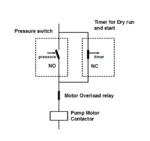rgc
Junior Member level 1
I have just bought an expensive pump that cannot run dry, but will eventually, so I want to design a microcontrolled circuit to shut off a relay and prevent that.
I believe that when it runs dry, it will spin a few times faster, draining a considerably larger ammount of current. If it were DC I would just put a resistor there, amplify the drop voltage and ADC that, but the pump works on AC and I have no idea how that would work.
Some questions:
- Is this the best way? Will this work at all? I mean, it would drain more current, wouldn't it?
- How the heck can I measure AD current on a PIC?
- I really don't know much of analog eletronics, therefore I don't venture there that much. Using a microcontroller here would be overkill? Can this be done easily without it?
Some info:
- I intend to use PIC12F683, which have a 4 channel 10-bit ADC, or it will be done by the central controller which is a PIC18F4550.
- The pump runs on 230V AC
I believe that when it runs dry, it will spin a few times faster, draining a considerably larger ammount of current. If it were DC I would just put a resistor there, amplify the drop voltage and ADC that, but the pump works on AC and I have no idea how that would work.
Some questions:
- Is this the best way? Will this work at all? I mean, it would drain more current, wouldn't it?
- How the heck can I measure AD current on a PIC?
- I really don't know much of analog eletronics, therefore I don't venture there that much. Using a microcontroller here would be overkill? Can this be done easily without it?
Some info:
- I intend to use PIC12F683, which have a 4 channel 10-bit ADC, or it will be done by the central controller which is a PIC18F4550.
- The pump runs on 230V AC
